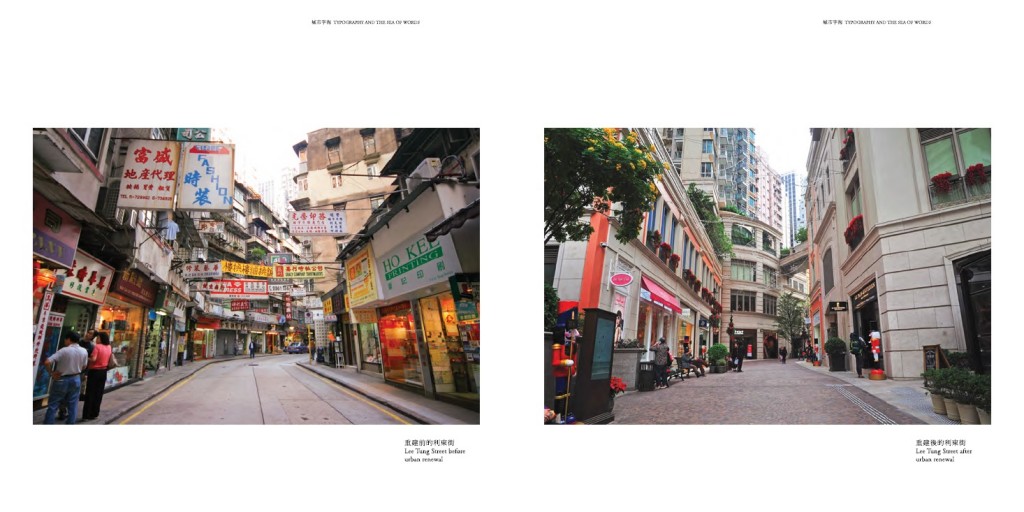《城市字海–香港城市景觀研究》免費下載 CACHe website English Version, 專題展覽, 最新消息, 活動回顧, 資源庫

(Please roll down for English)
學書法的人總說「人端字正」,意謂一個人的字可以呈現他的內涵,品行端正者,字亦端正。那麼,我們是否也能藉著觀察文字,去了解一個城市?在香港高度濃縮的城市空間中的稠密字海,又展示了這個地方的甚麼面向?
城市字海,曾被視為香港標誌,見於過去的彌敦道,也見於重建前的利東街。除了高掛在外牆上,用各種不同原料做成的商鋪招牌、燈箱廣告外,還有唐樓牆外的「搧灰字」、玄關梯間的小招牌、「水牌」,標示著利東街曾有各個源流各異的商會﹑同鄉會﹑體育會等社團在此落戶。這片看似雜亂無章的字海,體現了多元、包容、尊重的香港本土美學精神,亦記錄了早年香港社會的發展。
紛陳的城市景觀,隨著不斷加速的城市更新而漸趨單一。就像今日的利東街,老字號、小店和混雜有機的字海一起,已被連鎖店取代。這種標榜保留昔日街道特色,實際上卻從空間格局、使用、到各種文字展示,都被統一高度管理的市區更新模式,成為了主流──旺角「波鞋街」變為運動主題商店街或商場,中環結志街露天街市變成老字號主題商店街……管理者可以決定店鋪的去留、以至他們招牌的展示方式。多元、自由、混雜的街道空間消失,城市字海的消亡,其實意味著生活與美學的消失與更替。
城市空間更新後的街道格局和營運模式,容不下有機互動的人文景觀。面對城市美學的消失與更替,大家除了懷舊之外,我們應如何開展關於保育城市景觀的討論?《城市字海–香港城市景觀研究》,嘗試以城市裡的文字為主軸,探討城市景觀保育的可能性。我們走訪多位一直為這城市造字的「文字工匠」。從手寫招牌、印刷老店、霓虹光管、鑿字、膠字招牌、木雕招牌,到電腦字體設計,我們透過出版《城市字海故事》,以他們造字的故事勾勒出城市字海中各式文字的構成、出現、消失與將來發展。此外,我們籌辦以《城市字海–香港城市景觀展覽》展示文字工匠的造字工藝,提出以文字為中心的城市觀察方法,解說城市字海的構成,探索香港的城市美學。
這次研究雖未能夠為保育城市景觀提出具體政策,但我們期望這個以文字為重點的人文研究能為討論提供養分,繼續探討城市字海作為香港重要的城市景觀的保育策略。
/免費下載
請 按此 免費下載電子版《城市字海–香港城市景觀研究》

Into the Sea of Words – an exploration into the vanishing urban aesthetics
A person’s uprightness is reflected in his/her legible handwriting, as calligraphy practitioners believe. Similarly, how can we get to know a city by its street typography? What characters does Hong Kong exhibit when we look carefully at the overwhelming sea of words in such a compact urban landscape?
A sea of words, once a dominant feature of Hong Kong, reminds us of the neon signs on both sides of Nathan Road as well as not-yet-renewed Lee Tung Street. Mounted high, the advertisement signs of all shapes and sizes, the grey plastic words written on the exteriors of old tonglau buildings as well as small shop signs and company directories upon the building’s ground entrance mark the co-existence of different associations representing various business, fellow villages in the mainland and sport clubs. The urban appearance might look a bit disorganised, but it actually reflects the spirits of diversity, inclusiveness and respectfulness in Hong Kong urban aesthetics, as well as the early development history of Hong Kong society.
Due to rapid urban renewal, the diverse urban landscape has been slowly turning monotonous. See Lee Tung Street as an example – the scene of old shops mixed with different calligraphic styles has now been replaced by chained shops. Dubbed as “conserving the old street’s characters”, the renewed street actually already loses its charm because of the strict and top-to-down management practice under the current urban redevelopment model.
Similar situations can be found on Sneaker Street in Mong Kok, Gage Street Open Market in Central, which have turned into themed shopping streets after the process of urban renewal. Whether the shops can stay or has to leave and how their shop signs should be presented are at management’ discretion. The disappearance of the sea of words, as well as the street landscape that once embraced the spirits of diversity, personal autonomy and differences, reflect the changed way of our living and the respective urban aesthetics.
The new urban layout and business model under the current urban redevelopment model can no longer cultivate an organic and interactive cultural landscape. In face of the vanishing urban aesthetics, how can we start the public discussion about conservation on urban landscape besides being merely nostalgic?
“Typography and the Sea of Words – The Study of Hong Kong Urban Landscape” puts the focus on the urban typography and tries to look into the possibilities for conservation on our urban landscape. We have visited several handwriting artisans in the city – from inscribing shop signs, letterpress printing, neon sign making, stencil making, acrylic and wood sign making to computer font design. Through in-depth interviews, their stories are presented here to sketch the picture of how this unique urban landscape was gradually formed, and how the sea of words has been vanishing gradually.
The exhibition also showcases the art of typography and the way to observe this unique urban landscape from the perspective of typography.
While the exhibition may not provide immediate answers to concrete policies on the conservation of urban landscape, it is hoped to contribute to future discussions with the respective information and analysis.
/Free Downlaod
Please click here to download the e-version of Typography and the Sea of Words – The Study of Hong Kong Urban Landscape
/香港賽馬會社區資助計劃 — 社區文化遺產保育計劃
The Hong Kong Jockey Club Community Project Grant: Community Cultural Heritage Plus
本計劃由香港賽馬會慈善信託基金捐助、長春社文化古蹟資源中心主辦,於社區舉辦不同類型活動,推廣保育信息,加深社區各持分者對歷史及社區文化遺產的認識,從而建立身份認同,投入參與社區古蹟保育,同時增強社區的凝聚力。香港賽馬會慈善信託基金於2005年起開展社區資助計劃,為夥伴機構提供三年一期的捐助,推行適切的社區服務,支援不同弱勢社群。
This project is funded by The Hong Kong Jockey Club Charities Trust and organised by the Conservancy Association Centre for Heritage. The project includes a series of programmes to promote heritage conservation. Through the strengthening of public understanding on domestic history and community cultural heritage, every stakeholder can foster their local identity and community cohesion and hence participate in the conservation of community heritages. Launched in 2005, HKJC Community Project Grant provided their partners with grants in three-year cycles, in order to deliver appropriate community services and support the underprivileged.
/長春社文化古蹟資源中心
The Conservancy Association Centre for Heritage (CACHe)
長春社文化古蹟資源中心(CACHe)於2005年成立,一直積極舉辦古蹟保育活動。我們將繼續秉承宗旨,推廣香港歷史文化,建立知識交流平台,鼓勵大眾參與社區文化遺產保育,建立社區身份認同。
Established in 2005, The Conservancy Association Centre for Heritage (CACHe) is committed to organising different heritage conservation activities. Our mission is to promote the history and culture of Hong Kong, to develop a knowledge exchange platform, and to encourage public engagement in the conservation of community cultural heritage and hence enhance the realisation of their social identities.







